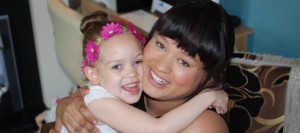World Retinoblastoma Week 2016
This week 8-15 May 2016 is world retinoblastoma awareness week. This is a great opportunity for us to spread the word in Australia about watching out for the “white glow” in children’s eyes.
Did you know that 50% of adults in the UK have never heard of retinoblastoma?
Here are a few quick facts about retinoblastoma to get you up to speed:
What is Retinoblastoma?
Retinoblastoma is a childhood cancer of the eye that develops in the cells of the retina at the back of the eye. Retinoblastoma is the most common malignancy of the eye in children, and affects more than 300 children each year in the USA. Retinoblastoma can affect one eye or both eyes.
Retinoblastoma usually occurs in children and babies under the age of 5 years, and is rare after the age of 6 years.
How would I know if my child has retinoblastoma?
Retinoblastoma is often noticed as a ‘white glow” of the eye in photographs. Sometimes there is a misalignment of the eyes, squint or strabismus. Often nothing has been noticed, and retinoblastoma is detected on a routine eye screen at the GP, paediatrician, optometrist or paediatric ophthalmologist. If you are concerned about any of these signs in your child, talk to your doctor, or arrange an eye examination with a paediatric ophthalmologist.
What causes Retinoblastoma?
About 40% of retinoblastoma cases are hereditary, meaning that there is someone else in the family with a history of retinoblastoma. If you have someone in your family who has had retinoblastoma, any children in the family under the age of 6 years need careful, detailed and regular dilated eye examinations by a paediatric ophthalmologist.
Any child can get retinoblastoma, and most cases of retinoblastoma do not run in families.
Early detection of retinoblastoma is vital for survival. Retinoblastoma is a fatal disease if left untreated.
About 83% of children are successfully treated and become long term survivors of retinoblastoma.
Treatment options for retinoblastoma focus on survival, and preservation of the eye. An eye may need to be surgically removed if the cancer is advanced.
The Childhood Eye Cancer Trust (CHECT) are based in the UK and do an amazing job of raising awareness of retinoblastoma. Please take a look at their website and their current media campaign for world retinoblastoma week:
https://chect.org.uk/mum-urges-parents-to-be-eye-aware/
CHECT have also put together a moving video about one families recent discovery of retinoblastoma in their 3 year old daughter Eliza’s eye after they noticed she had a lazy eye. The video is well worth watching as it follows them on their journey through diagnosis and treatment:
https://www.youtube.com/watch?v=xgUyFJZw3wg
For further information and facts about Retinoblastoma in Australia, please visit:
https://childrenscancer.canceraustralia.gov.au/types-childrens-cancers/retinoblastoma/pdf
If you are in Sydney or NSW, and you are at all concerned about your child’s eyes, please call us to book in an eye examination at Sydney Ophthalmic Specialists with one of our paediatric ophthalmologists on (02) 9241 2914.


